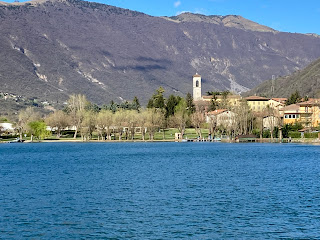Bergamo's tranquil lake
 |
| Monasterolo del Castello looks over the southern end of Lago di Endine |
Surrounded by banks of thick reeds, which provide an ideal
breeding ground for fish and birds, the lake offers a tranquil spot for both
local people and tourists to relax in.
You can walk all the way round Lago di Endine’s 14
kilometres (8.7 miles) of shores on well-maintained level footpaths, and take in its unique
beauty, while pausing occasionally to take pictures, or rest at the many
benches and picnic tables thoughtfully placed around the lake.
In the summer, the clean waters of the lake are ideal
for swimming, sailing, canoeing, and windsurfing, but motor boats are not
allowed on the lake to preserve the peaceful atmosphere.
During the winter, the lake can sometimes become
frozen over. People used to skate on it in the past, but this is now forbidden
by the municipality for safety reasons.
.jpg) |
| Snow-capped mountain peaks are visible in this winter view at the northern end |
The clear waters of Lago di Endine are regularly replenished
by torrents of water that descend from the slopes of the surrounding mountains.
The surrounding villages of Monasterolo del Castello, Endine Gaiano,
Spinone al Lago and Ranzanico all have bars and restaurants with terraces with
superb views over the lake. Local dishes and fresh fish from the lake, such as
perch, carp, eels, pike, and tench, are on the menus.
There are plenty of car parks for visitors to use situated
above the lake and there are regular buses from Bergamo to Lago di Endine that stop at various points along the lake. The journey takes around 35 minutes by car and up to 50 minutes by bus.





.jpg)
.JPG)
.JPG)





.jpg)
.jpg)
.jpg)
.jpg)
.jpg)

